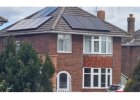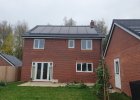This is a terraced 2-bed with external wall insulation, 6x420W solar panels and a 6kWh battery. More draughtproofing, ventilation, floor insulation and some window upgrades are being planned. All windows are double glazed, some with secondary glazing, and hot water and heating are provided by a condensing gas boiler which at some stage will be replaced by a heat pump.
Further information:
Insulation
The external wall insulation (EWS) was done 9 years ago when a 'green deal home improvement fund' grant was briefly available to a limited number of households. It cost approximately £6k including the back extension, of which £4k was covered by the grant at that time. It consists of 100cm of EPS (expanded polystyrene) covered with a hard weatherproof and fire resistant render layer (Ceresit system). It greatly improved the look of the property and kept the solidish brick walls dryer and warmer in winter and has proved durable so far.
The principle learning point from the EWS installation was to ensure that polystyrene blocks are fitted to spec (some of mine did not have mortar all round the edge to avoid air flow behind the blocks) and that all edges of the overall insulation layer are properly sealed (in my case the edge adjacent to a garden fence was not sealed properly). Also ensure that any holes such as for extractor fans slope downwards towards the outside to avoid condensation running back into the house. Another is to choose a supplier who is likely to continue operating for long enough to fix any issues, to avoid falling back on the insurance-backed guarantee.
Solar Panels
The solar panels were installed under the Wiltshire and Swindon 'Solar Together' scheme by Infinity Renewables: 6x430W panels, Growatt inverter and 6kWh battery, total price including scaffolding etc £7,783. They were very helpful and flexible, but there were some snags. The pre-installation survey did not show that roof repairs were needed, and this was only discovered when scaffolding had been erected and the installers came to start. It then took a long time to find a suitable roofer, and negotiating with the scaffolder to keep the scaffolding up during this time. Then the survey was reviewed and it was found that the panels originally proposed for the flat roof would not all fit and that the smaller number that would fit would not work with the inverter. In the end to get the job finished while the scaffolding was still up I settled for 6 panels on the main roof, on the understanding that flat roof panels could be added later. However this will probably not be economical to do as a separate installation. I declined bird neting as they wanted to charge £600 for this, but did opt for a socket to provide power from the battery (if charged) during a power cut (in case that happens more often in future!)
Having said all that I am pleased with the smaller cheaper installation. The photos show the inverter and battery in the attic, and a screenshot of the performance on one October day with reasonable sunshine. On cloudy days the panels just about cover background daytime usage. On sunny days they charge the battery and that can last a full 24 hours (with gas boiler not heat pump). The chart shows that there was not enough sun the previous day to charge the battery to last overnight, but on the day pictured there as enough to charge it and last till midnight (and in fact till the morning). On sunny Summer days I export a few kWh to the grid each day (though this is unlikely when I get a heat pump). I signed up for the 15p Good Energy export tariff soon after installation (but have still not had confirmation at 24th Oct 24!)
Other Measures
Other measures, firstly floor repairs and some insulation and thorough draught-proofing, need to be completed to feel the full effect and substantially reduce the heating demand on cold windy days. Heat recovery from waste shower water would also reduce the hot water demand.
A Futureproof survey from CSE, which is still currently advertised as available with a discount from the councils in Swindon and Wiltshire, was done December 2023 to help assess the relative benefit of additional measures. This is still in the process of evaluation and finding suppliers.


